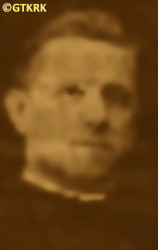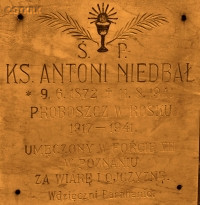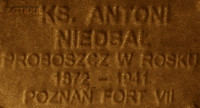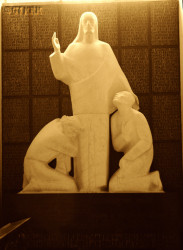Roman Catholic
St Sigismund parish
05-507 Słomczyn
85 Wiślana Str.
Konstancin deanery
Warsaw archdiocese, Poland
full list:
displayClick to display full list

searchClick to search full list by categories
wyświetlKliknij by wyświetlić pełną listę po polsku

szukajKliknij by przeszukać listę wg kategorii po polsku

Martyrology of the clergy — Poland
XX century (1914 – 1989)
personal data
surname
NIEDBAŁ
forename(s)
Anthony Marian (pl. Antoni Marian)
function
diocesan priest
creed
Latin (Roman Catholic) Church RCmore on
en.wikipedia.org
[access: 2014.09.21]
diocese / province
Gniezno and Poznań archdiocese (aeque principaliter)more on
www.archpoznan.pl
[access: 2012.11.23]
date and place
of death
11.08.1941

KL Posenconcentration camp
today: Poznań, Poznań city pov., Greater Poland voiv., Poland
more on
en.wikipedia.org
[access: 2022.01.09]
details of death
After the abdication on 09.09.1918 of the German Emperor William II Hohenzollern; after the signing on 11.11.1918 by the Allies and the Germans, in a staff wagon in Compiègne, at the headquarters of French Marshal Ferdinand Foch, of an armistice and ceasefire — which de facto meant the end of World War I; and also after the transfer on 11.11.1918 of supreme command over the army by the Regency Council — operating in the so‐called Germ. Königreich Polen (Eng. Polish Kingdom) occupied by the Central Powers (Germany and Austria–Hungary) — to Brigadier Joseph Piłsudski and appointing him Commander‐in‐Chief of the Polish Army, which de facto meant the rebirth of the Polish state, covering, however, only the Germ. Königreich Polen, i.e. the Polish territory till 1915under Russian rule, and excluding the Prussian partition; Greater Poland — as the Prussian Germ. Provinz Posen (Eng. Poznań Province) — was still formally part of the German state. In the towns and villages of Greater Poland, People's Councils began to be established at that time, following an appeal by the Polish Supreme People's Council in Poznań. In 11.1918, co‐organized numerous rallies in the Germ. Kreis Filehne (Eng. Wieleń County) — i.e. in Gulcz, Drawsko, Miały, Piłka, Pęcków, Wieleń, Wrzyszczyn and in his parish Rosko — with „overflowing halls” preparing for the elections of local people's councils. The process ended with a large rally in Wieleń on 28.11.1918, after the establishment of the District People's Council in that town on 24.11.1918.
However, this was only the beginning of the struggle. On 27.12.1918, the Greater Poland Uprising broke out in Poznań. His parish Rosko found itself in the area controlled by the insurgents. However, on 07.02.1919, the Germans attempted to capture it — the attack of the Wieleń unit, which was controlled by the Germans, was repelled. The Uprising formally ended on 16.02.1919 with the armistice in Trier, enforced by the victorious Entente states, under which the Polish insurgent Greater Poland Army was recognized as an allied force and a border was set, which „German troops were forbidden to cross”, leaving most of Greater Poland outside their influence. However, it was not until the Treaty of Versailles, concluded on 26.06.1919, that Greater Poland was formally awarded to Poland. The fighting for the Wieleń county continued though till 04.1920 — even after the ratifications of the treaty and its entry into force on 10.01.1920. At that time, the lands on the southern bank of the Noteć, including Wieleń and Rosko, found themselves in independent Poland.
After German invasion of Poland in 09.1939 and start of the World War II, after start of German occupation, arrested on 08.05.1941 by the Germans.
Jailed in KL Posen (Fort VII) concentration camp where perished.
According to the death certificate in the registers of the civil registry office in Poznań, No. P 2933/1941, the „honest” otherwise German „medical doctors” and formalists — and at the same time, unrivaled fairy tale spinners — noted the cause of death was „intestinal inflammation and circulation disorders”.
cause of death
extermination
perpetrators
Germans
sites and events
KL PosenClick to display the description, Ribbentrop‐MolotovClick to display the description, Pius XI's encyclicalsClick to display the description, Greater Poland UprisingClick to display the description
date and place
of birth
09.06.1872

Zbąszyńtoday: Zbąszyń gm., Nowy Tomyśl pov., Greater Poland voiv., Poland
more on
en.wikipedia.org
[access: 2021.06.20]
parents
NIEDBAŁ Joseph
🞲 ?, ? — 🕆 ?, ?

LEHMANN Mary
🞲 ?, ? — 🕆 ?, ?
presbyter (holy orders)
ordination
01.12.1902

Gnieznotoday: Gniezno urban gm., Gniezno pov., Greater Poland voiv., Poland
more on
en.wikipedia.org
[access: 2021.12.18]
Assumption of the Blessed Virgin Mary RC archcathedral churchmore on
en.wikipedia.org
[access: 2025.03.14]
positions held
1917 – 1941
parish priest — Roskotoday: Wieleń gm., Czarnków/Trzcianka pov., Greater Poland voiv., Poland
more on
en.wikipedia.org
[access: 2021.07.18] ⋄ St Stanislav the Bishop and Martyr RC parish ⋄ Czarnkówtoday: Czarnków gm., Czarnków/Trzcianka pov., Greater Poland voiv., Poland
more on
en.wikipedia.org
[access: 2021.06.20] RC deanery
1908 – 1917
administrator — Żydowotoday: Rokietnica gm., Poznań pov., Greater Poland voiv., Poland
more on
en.wikipedia.org
[access: 2021.07.18] ⋄ St Nicholas the Bishop and Confessor RC parish ⋄ Obornikitoday: Oborniki gm., Oborniki pov., Greater Poland voiv., Poland
more on
en.wikipedia.org
[access: 2020.11.27] RC deanery
1907 – 1908
vicar — Wyskoćtoday: Kościan gm., Kościan pov., Greater Poland voiv., Poland
more on
en.wikipedia.org
[access: 2021.07.18] ⋄ St Andrew the Apostle RC parish ⋄ Kościantoday: Kościan gm., Kościan pov., Greater Poland voiv., Poland
more on
en.wikipedia.org
[access: 2021.07.18] RC deanery
1907
vicar — Modrzetoday: Stęszew gm., Poznań pov., Greater Poland voiv., Poland
more on
en.wikipedia.org
[access: 2021.06.20] ⋄ St Giles the Abbot RC parish ⋄ Buktoday: Buk gm., Poznań pov., Greater Poland voiv., Poland
more on
en.wikipedia.org
[access: 2021.06.20] RC deanery
1905 – 1907
vicar — Brodytoday: Lwówek gm., Nowy Tomyśl pov., Greater Poland voiv., Poland
more on
en.wikipedia.org
[access: 2021.12.18] ⋄ St Andrew the Apostle RC parish ⋄ Lwówektoday: Lwówek gm., Nowy Tomyśl pov., Greater Poland voiv., Poland
more on
en.wikipedia.org
[access: 2020.11.27] RC deanery
1903 – 1904
vicar — Lubasztoday: Lubasz gm., Czarnków/Trzcianka pov., Greater Poland voiv., Poland
more on
en.wikipedia.org
[access: 2021.06.20] ⋄ Nativity of the Blessed Virgin Mary RC parish ⋄ Czarnkówtoday: Czarnków gm., Czarnków/Trzcianka pov., Greater Poland voiv., Poland
more on
en.wikipedia.org
[access: 2021.06.20] RC deanery
1902 – 1903
vicar — Cerekwicatoday: Rokietnica gm., Poznań pov., Greater Poland voiv., Poland
more on
en.wikipedia.org
[access: 2021.06.20] ⋄ Exaltation of the Holy Cross RC parish ⋄ Obornikitoday: Oborniki gm., Oborniki pov., Greater Poland voiv., Poland
more on
en.wikipedia.org
[access: 2020.11.27] RC deanery
till 1902
student — Gnieznotoday: Gniezno urban gm., Gniezno pov., Greater Poland voiv., Poland
more on
en.wikipedia.org
[access: 2021.12.18] ⋄ philosophy and theology, Archbishop's Practical Theological Seminary (Lat. Seminarium Clericorum Practicum)
from 1898
student — Poznańtoday: Poznań city pov., Greater Poland voiv., Poland
more on
en.wikipedia.org
[access: 2021.07.18] ⋄ philosophy and theology, Archbishop's Theological Seminary (Collegium Leoninum)
others related
in death
CEGIEŁClick to display biography Thaddeus Vladimir Cornelius, FLACHClick to display biography Julian, GRAMLEWICZClick to display biography Edward, HARASYMOWICZClick to display biography Vincent, JANICKIClick to display biography Stanislav, JANKOWSKIClick to display biography Alphonse, KUBIKClick to display biography Alexander, ŁUKOWSKIClick to display biography Steven, MAŁECKIClick to display biography Stanislav, MANITIUSClick to display biography Gustav, MIROCHNAClick to display biography Steven Marian (Fr Julian), MZYKClick to display biography Louis, NOWAKClick to display biography Francis Joseph, PIOTROWSKIClick to display biography Ignatius, POPRAWSKIClick to display biography Marian, SĘKIEWICZClick to display biography Mauritius Vaclav, STEINMETZClick to display biography Paul, SZREYBROWSKIClick to display biography Casimir, TYMAClick to display biography Joseph, WIŚNIEWSKAClick to display biography Mary, WOŹNIAKClick to display biography Albin
sites and events
descriptions
KL Posen: German Posen — Fort VII — camp founded in c. 10.10.1939 in Poznań till mid of 11.1939 operated formally as Germ. Konzentrationslager (Eng. concentration camp) KL Posen, and this term is used throughout the White Book, also later periods. It was first such a concentration camp set up by the Germans on Polish territory — in case of Greater Poland (Wielkopolska) directly incorporated into German Reich. In 10.1939 in KL Posen for the first time Germans used gas to murder civilian population, in particular patients of local psychiatric hospitals. From 11.1939 the camp operated as German political police Gestapo prison and transit camp (Germ. Übergangslager), prior to sending off to concentration camps, such as KL Dachau or KL Auschwitz. In 28.05.1941 the camp was rebranded as police jail and slave labour corrective camp (Germ. Arbeitserziehungslager). At its peak up to 7‐9 executions were carried in the camp per day, there were mass hangings of the prisoners and some of them were led out to be murdered elsewhere, outside of the camp. Altogether in KL Posen Germans exterminated approx. 20,000 inhabitants of Greater Poland (Wielkopolska) region, including many representatives of Polish intelligentsia, patients and staff of psychiatric hospitals and dozen or so Polish priests. Hundreds of priests were held there temporarily prior to transport to other concentration camps, mainly KL Dachau. From 03.1943 the camp had been transformed into an industrial complex (from 25.04.1944 — Telefunken factory manufacturing radios for submarines and aircrafts). (more on: www.wmn.poznan.plClick to attempt to display webpage
[access: 2019.02.02], en.wikipedia.orgClick to attempt to display webpage
[access: 2013.12.27])
Ribbentrop‐Molotov: Genocidal Russian‐German alliance pact between Russian leader Joseph Stalin and German leader Adolf Hitler signed on 23.08.1939 in Moscow by respective foreign ministers, Mr. Vyacheslav Molotov for Russia and Joachim von Ribbentrop for Germany. The pact sanctioned and was the direct cause of joint Russian and German invasion of Poland and the outbreak of the World War II in 09.1939. In a political sense, the pact was an attempt to restore the status quo ante before 1914, with one exception, namely the „commercial” exchange of the so‐called „Kingdom of Poland”, which in 1914 was part of the Russian Empire, fore Eastern Galicia (today's western Ukraine), in 1914 belonging to the Austro‐Hungarian Empire. Galicia, including Lviv, was to be taken over by the Russians, the „Kingdom of Poland” — under the name of the General Governorate — Germany. The resultant „war was one of the greatest calamities and dramas of humanity in history, for two atheistic and anti‐Christian ideologies — national and international socialism — rejected God and His fifth Decalogue commandment: Thou shall not kill!” (Abp Stanislav Gądecki, 01.09.2019). The decisions taken — backed up by the betrayal of the formal allies of Poland, France and Germany, which on 12.09.1939, at a joint conference in Abbeville, decided not to provide aid to attacked Poland and not to take military action against Germany (a clear breach of treaty obligations with Poland) — were on 28.09.1939 slightly altered and made more precise when a treaty on „German‐Russian boundaries and friendship” was agreed by the same murderous signatories. One of its findings was establishment of spheres of influence in Central and Eastern Europe and in consequence IV partition of Poland. In one of its secret annexes agreed, that: „the Signatories will not tolerate on its respective territories any Polish propaganda that affects the territory of the other Side. On their respective territories they will suppress all such propaganda and inform each other of the measures taken to accomplish it”. The agreements resulted in a series of meeting between two genocidal organization representing both sides — German Gestapo and Russian NKVD when coordination of efforts to exterminate Polish intelligentsia and Polish leading classes (in Germany called «Intelligenzaktion», in Russia took the form of Katyń massacres) where discussed. Resulted in deaths of hundreds of thousands of Polish intelligentsia, including thousands of priests presented here, and tens of millions of ordinary people,. The results of this Russian‐German pact lasted till 1989 and are still in evidence even today. (more on: en.wikipedia.orgClick to attempt to display webpage
[access: 2015.09.30])
Pius XI's encyclicals: Facing the creation of two totalitarian systems in Europe, which seemed to compete with each other, though there were more similarities than contradictions between them, Pope Pius XI issued in 03.1937 (within 5 days) two encyclicals. In the „Mit brennender Sorge” (Eng. „With Burning Concern”) published on 14.03.1938, condemned the national socialism prevailing in Germany. The Pope wrote: „Whoever, following the old Germanic‐pre‐Christian beliefs, puts various impersonal fate in the place of a personal God, denies the wisdom of God and Providence […], whoever exalts earthly values: race or nation, or state, or state system, representatives of state power or other fundamental values of human society, […] and makes them the highest standard of all values, including religious ones, and idolizes them, this one […] is far from true faith in God and from a worldview corresponding to such faith”. On 19.03.1937, published „Divini Redemptoris” (Eng. „Divine Redeemer”), in which criticized Russian communism, dialectical materialism and the class struggle theory. The Pope wrote: „Communism deprives man of freedom, and therefore the spiritual basis of all life norms. It deprives the human person of all his dignity and any moral support with which he could resist the onslaught of blind passions […] This is the new gospel that Bolshevik and godless communism preaches as a message of salvation and redemption of humanity”… Pius XI demanded that the established human law be subjected to the natural law of God , recommended the implementation of the ideal of a Christian state and society, and called on Catholics to resist. Two years later, National Socialist Germany and Communist Russia came together and started World War II. (more on: www.vatican.vaClick to attempt to display webpage
[access: 2023.05.28], www.vatican.vaClick to attempt to display webpage
[access: 2023.05.28])
Greater Poland Uprising: Military insurrection of Poles of former German Germ. Posen Provinz (Eng. Poznań province) launched against German Reich in 1918‐1919 — after the abdication on 09.11.1918 of the German Emperor William II Hohenzollern; after the armistice between the Allies and Germany signed on 11.1.1918 in the HQ wagon in Compiègne, the headquarters of Marshal of France Ferdinand Foch — which de facto meant the end of World War I — against the German Weimar Republic, established on the ruins of the German Empire, aiming to incorporate lands captured by Prussia during partitions of Poland in XVIII century into Poland. The Republic of Poland, reborn on 11.11.1918, initially formally included only the so‐called Germ. Königreich Polen (Eng. Kingdom of Poland), i.e. the territory that had been under Russian rule until 1915 and then under the control of Central States (Germany and Austria–Hungary), but did not include the Prussian partition. Started on 27.12.1918 in Poznań and ended on 16.02.1919 with the armistice pact in Trier, forced by the victorious Entente states, which included provisions ordering Germany to cease operations against Poland and, importantly, recognizing the Polish insurgent Greater Poland Army as an allied armed force of the Entente. De facto it turned out to be a Polish victory, confirmed in the main peace treaty after World War I, the Treaty of Versailles of 28.06.1919, which came into force on 10.01.1920 and in which most of the lands of the Prussian partition were recognized as Polish. Many Polish priests took part in the Uprising, both as chaplains of the insurgents units and members and leaders of the Polish agencies and councils set up in the areas covered by the Uprising. In 1939 after German invasion of Poland and start of the World War II those priests were particularly persecuted by the Germans and majority of them were murdered. (more on: en.wikipedia.orgClick to attempt to display webpage
[access: 2016.08.14])
sources
personal:
www.wtg-gniazdo.orgClick to attempt to display webpage
[access: 2012.11.23]
bibliographical:
„Martyrology of the Polish Roman Catholic clergy under nazi occupation in 1939‐1945”, Victor Jacewicz, John Woś, vol. I‐V, Warsaw Theological Academy, 1977‐1981
„Social Activist Priests in Greater Poland”, collective work, Biographical Dictionary, vol. 2 I‐O, 2007
original images:
www.wtg-gniazdo.orgClick to attempt to display webpage
[access: 2012.11.23], www.wtg-gniazdo.orgClick to attempt to display webpage
[access: 2012.11.23]
LETTER to CUSTODIAN/ADMINISTRATOR
If you have an Email client on your communicator/computer — such as Mozilla Thunderbird, Windows Mail or Microsoft Outlook, described at WikipediaPatrz:
en.wikipedia.org, among others — try the link below, please:
LETTER to CUSTODIAN/ADMINISTRATORClick and try to call your own Email client
If however you do not run such a client or the above link is not active please send an email to the Custodian/Administrator using your account — in your customary email/correspondence engine — at the following address:

giving the following as the subject:
MARTYROLOGY: NIEDBAŁ Anthony Marian
To return to the biography press below:
 Click to return to biography
Click to return to biography














